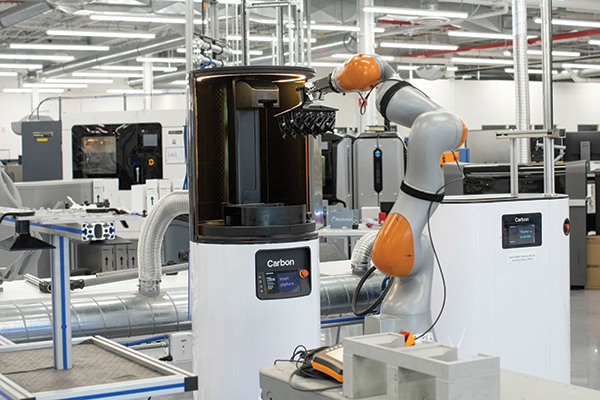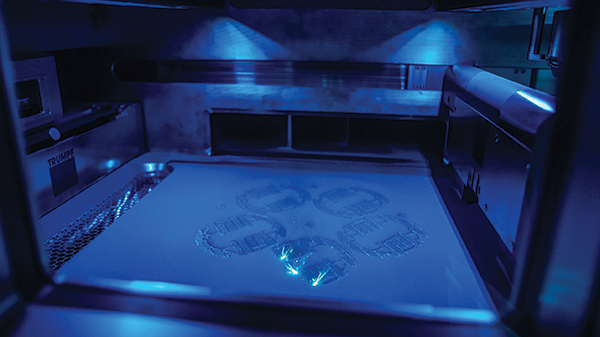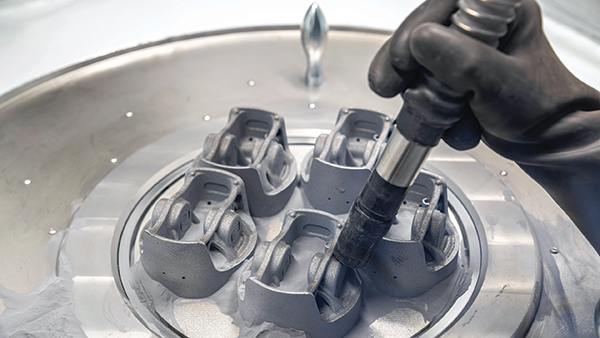The lubricants industry is sometimes like a buoy, tending to reliably stay in place while rising and falling with swells in the ocean. However, as time passes and new technology emerges, the lubricants industry will inevitably face significant challenges. The rise of the electric vehicle is already posing a threat—as well as some opportunities. Will 3D printing be the next big disruption?
After the first desktop 3D printer was invented in 1986, enthusiastic proponents predicted that every household would soon attach one to a personal computer and use it to make various items. While they are not yet as common as inkjet printers, consumer-grade 3D printers are used widely in STEM classrooms, where they engage students and provide hands-on experience while teaching principles of design and engineering.
Meanwhile, desktop 3D printers reside in many engineering offices and laboratories and produce prototypes to accelerate the design process. They are deployed on ships and in other remote locations. In fact, at the International Space Station—a mere 250 miles above Earth—astronauts tested a 3D printer by making spare parts and tools. NASA anticipates that 3D printers will help enable future long-term, long-distance space exploration and colonization.
Pundits have also predicted that large-scale, specialized 3D printers will soon be implemented in additive manufacturing and replace conventional production methods that rely upon metalworking fluids and other lubricants. Some recent developments using additive manufacturing are narrower in scope and much smaller in scale than this prediction, such as novel bioprinting for medical and dental applications, filling gaps in inventories and customization of vehicles.
However, industrial-scale 3D printers are becoming more available for processing plastics and metals. The automotive industry is using additive manufacturing technologies for on-demand production of parts and integrating 3D printers with robots for manufacturing. The aviation industry is using the process to make new lightweight composites, while the construction industry has transported massive 3D methodology to build schools in remote locations.
Adapt or Die?
It may be advantageous—or necessary—for the metalworking and lubricant industries to adapt to technologies that are making fundamental changes in the ways that customers are designing and manufacturing products and managing inventories and supply chains.
At present, many manufacturing lines use subtractive processes, such as punching disks from sheets of aluminum or cutting, drilling and grinding blocks of steel, cast iron or titanium to sculpt parts for automotive and aviation applications. Operations are optimized to continuously manufacture thousands, millions or more nominally identical objects. Subtractive processes are also used to carve tools, dies, nozzles and molds for use in plastics molding and other established manufacturing processes.
Precision, pace and turnaround time are priorities.
Metalworking fluids are essential. They lubricate and cool tools and workpieces, remove swarf (chips and particles) and contaminants, and impart corrosion-resistant surface treatments. The manufacturing equipment includes such lubricated components as rollers, bearings, gear boxes, motors, extruders and electric fans. Some equipment is controlled by computers.
Likewise, 3D printers are computer-controlled and have lubricated components. But in contrast, a 3D printer forms an object by making a series of different layers, one at a time, in a stack. This is an additive process, similar to making a stack of pancakes. With 3D printers, it is possible to make individual or small numbers of customized objects while wasting much less material than in subtractive processes, in principle.
Table 1. Properties and Applications of Commercially Available Thermoplastic Filaments with Print Temperatures from 180°C-250°C
| 1 | 2 | 3 | 4 |
|---|---|---|---|
| ABS | Acrylonitrile butadiene styrene | Durable, strong, lightweight | Automotive parts, kitchen appliances, electronic housings, toys |
| Nylon | Polyamide | Stronger, more durable, flexible and wear resistant than ABS | Tools, mechanical components, machine parts |
| PET | Polyethylene terephthalate | Stable, recyclable | Food containers, kitchen utensils |
| PLA | Polylactic acid | Biodegradable, not as strong and durable as ABS, prints quickly | Surgical implants, food packaging, disposable tableware, consumer items |
| PVA | Polyvinyl alcohol | Biodegradable, non-toxic, durable | Co-extruded with PLA as a support to make parts with overhangs |
| TPE | Thermoplastic elastomers | Elasticity, abrasion resistance, little shrinkage | Automotive parts, kitchen appliances, wearables, smartphone cases, toys |
| Conductive resins | ABS or PLA filled with C particles | Conductive | Low-voltage electronic circuits, LEDs, sensors, Arduino projects |
| Other filled resins | Resin + stone dust, chalk, wood fiber, metal (Al, Cu, Fe, bronze, brass) powder, carbon fiber | Customizable appearance, properties depend upon type and level of filler | Decorative items, furniture, hardware, jewelry, magnets |
Inkjet and laser printers were forerunners of 3D printers. In 2D printing, users run software to prepare text or graphics and translate the contents into a file. Then a printer reads the file and forms an image on a sheet of paper. For example, an inkjet printer uses a printhead to select an ink cartridge and moves the printhead and a sheet of paper while dispensing droplets of ink through a nozzle. Seconds or minutes later, the printer completes the process and ejects the sheet of paper—unless it jams in the printer, a cartridge runs out of ink or a nozzle becomes clogged.
In essence, 3D printers are more sophisticated versions of inkjet printers. Users apply CAD (computer-aided design) software to design models of objects. They can view a model on a computer screen or print its image on paper, cobble together and test a 3D prototype, then adjust the design and repeat. Or they run software to operate a 3D printer that can automatically make a prototype to accelerate the design process.
A 3D printer is a machine that deposits layers of material that correspond to horizontal slices of a design. Many 3D printers use a spool of polymer filament, 1.75 or 3.00 millimeters in diameter, similar to that in a fishing reel or a string trimmer. The 3D printer holds the spool and dispenses portions of filament. Then the printhead heats the resin and extrudes it through a nozzle as it moves in two dimensions. The printer pauses repeatedly to uncoil and heat portions of filament and raise the printhead as needed. Hours later, a 3D object has been formed on a platform inside the printer, barring mechanical issues or design flaws.
What Are the Trade-offs?
There is obvious appeal in using 3D printers to automatically make customized objects and prototypes. Software can be reused repeatedly and easily adjusted to modify a design. CAD and 3D printing provide opportunities for brainstorming and inventing new forms, especially objects with unusual features (complex shapes, cavities, overhangs) that may be difficult to make using other methods.
However, operators must choose appropriate polymers and take a trial-and-error approach to adjust parameters such as temperature, printhead speed and layer thickness. Other trade-offs include waiting patiently while a 3D printer forms an object, debugging software and fixing mechanical glitches, broken filaments or clogged nozzles.
Scaling up 3D printing technologies and putting them into practice in additive manufacturing applications involves even more trade-offs. Certain circumstances are motivating the use of novel additive manufacturing technology instead of a traditional manufacturing process.
At present, the advantages of 3D printing favor applications in which customization adds substantial value and volumes and inventories are low—not the large-scale manufacturing processes that are the bread and butter of the metalworking fluid industry.
Bioprinting is the application of 3D printers to prepare human organs for transplant. NASA recently sponsored a contest to challenge researchers to “create thick, vascularized human organ tissue in an in-vitro environment to advance research and benefit medicine on long-duration missions and on Earth.” Two winning teams from the Wake Forest Institute for Regenerative Medicine used 3D printing to construct porous polymeric scaffolds for liver tissue. They kept the tissue alive by circulating oxygenated fluid and nutrients through the scaffold for 30 days. Elsewhere, researchers are using 3D printed scaffolds to develop artificial bones and various types of tissues and organs.
A more mature application is the now routine use of 3D printing to make custom dental implants, orthotics and dentures.

3D printers are particularly well-suited to making unusual or unavailable parts on demand to bridge gaps in inventories. Entrepreneurs at an aftermarket supplier of parts for classic vehicles (3DPrintedFordParts.com) use 3D printers to produce various ABS plastic bits and pieces that customers need to maintain their vintage 1967-1979 bumpside, dentside and Bronco trucks.
The Ford Maverick pickup truck was designed with features that allow customers to use 3D printing to personalize their vehicles. The Ford Integrated Tether System (FITS) in these trucks provides slots to accommodate accessories such as adjustable storage and cup holders. Vehicle owners can design and make these accessories using their own 3D printers or third-party services.
Likewise, the BMW Group, based in Munich, Germany, offers customers their choice of 3D printed components to customize their MINIs.
While interesting, these 3D printing applications are more incremental than disruptive to the automotive industry, at least thus far.
Additive Manufacturing and Beyond
Leading-edge manufacturers are recognizing the potential for using 3D printing technologies to not only accelerate their design cycles but also fundamentally alter their production procedures. Industrial-scale additive manufacturing requires appropriate hardware, software and materials, and inventors and entrepreneurs are partnering with manufacturers to provide them.
Stratasys—which has offices in Rehovot, Israel, and Eden Prairie, Minnesota—is developing technologies to extend 3D printing to areas where conventional manufacturing techniques are less competitive. Two such opportunities are the production of structures that cannot be machined or molded by other means, and the less costly production for low- and medium-volume applications. The company’s rapid, flexible 3D printers and composite materials are used to make tools, components with complex geometries and replacement parts for aviation and automotive applications—all on-demand, providing competitive advantages.

The global automotive industry is pushing the frontier to apply 3D printers to develop prototypes and manufacture customized sports car seating (Porsche), brake components (Ford), jigs and fixtures for assembly lines (Volkswagen), lug nuts (Ford), and even electric vehicles (XEV), motorcycles (APWORKS) and autonomous electric shuttles (Local Motors).

At Ford’s Advanced Manufacturing Center in Redford, Michigan, a mobile robot roams a manufacturing line, operating 3D printers that produce parts as needed. This simplifies inventories and supply chains and allows staff to undertake other duties. Robots and printers communicate efficiently through a patent pending software interface.
Additive Metal Manufacturing—based in Concord, Ontario, Canada—applies 3D printing and lasers to make components from metal powders, such as stainless steel and aluminum alloys. Such additive manufacturing techniques as laser powder bed fusion can be tuned to control the grain structure in metal components and significantly improve mechanical properties, like hardness and strength, according to researchers at Tsinghua University and the National University of Singapore.
Additive manufacturing technology is not confined to the factory floor. A massive robotic BOD2 printer from Copenhagen, Denmark-based COBOC suspended on an overhead gantry was programmed to extrude layers of concrete and construct the walls of a one-room elementary school at a rural site in southeastern Africa. The additive manufacturing approach saved time, cost and materials; an estimate of its environmental footprint was 50% of that of traditional construction methods. Graduates of this school will be persuasive evidence of the potential of 3D printers and additive manufacturing to change lives.
This project was undertaken by 14Trees, a foundation operating in Lilongwe, Republic of Malawi, dedicated to the development of affordable housing in Africa. 14Trees is a joint venture between Zug, Switzerland-based Holcim Group, an innovator in sustainable construction, and London, United Kingdom-based CDC Group plc, the developmental finance institution of the U.K. government.
Mary Moon, Ph.D., has experience formulating, testing and manufacturing lubricating oils and greases and polymers. She has served as Chair of the Philadelphia Section of STLE and Technical Editor of The NLGI Spokesman and received the Clarence E. Earle Memorial Award (2018) and the Golden Grease Gun Award (2022) from NLGI. She is currently working as a professional writer and editor. Contact her at mmmoon@ix.netcom.com
